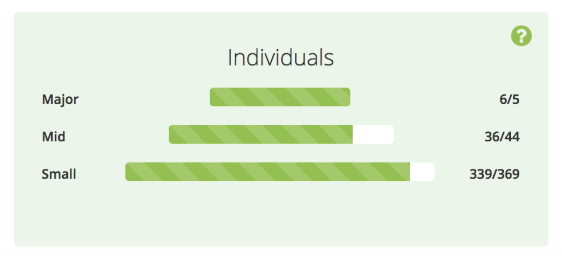Guest Post by Steven Shattuck of Bloomerang
As nonprofits develop their brand in the community and the programming for their constituents, it becomes more important to create a concrete strategic growth plan. This plan contains the specific steps and objectives that must be reached for that nonprofit to achieve big-picture goals.
The strategic growth plan generally consists of goals and objectives for each of the different nonprofit departments, mapping out pathways for the fundraising, marketing, and development teams to work and flourish together.
Given the importance and wide-reaching impact of your nonprofit’s growth strategy, you need to make absolutely sure every aspect of the plan is as effective and efficient as possible. While your nonprofit works on this strategy, whether on your own or with a consultant, keep the following tips in mind:
- Set concrete, specific, and measurable objectives.
- Focus on the median donor.
- Change your mind about nonprofit overhead.
- Keep an eye on emerging nonprofit trends.
- Remember, it’s ok to ask for help.
Ready to dive a little deeper into how each of these tips impacts nonprofit growth strategies? Let’s get started.
1. Set concrete, specific, and measurable objectives.
The hierarchy of items your nonprofit wants to accomplish can be broken down into three different levels:
- First, at the top, there’s your mission. Your mission is the big-picture purpose for your organization. This is the solution to the problem you identified in the community and the reason your organization was established. For instance, your mission might be to find a loving home for every dog.
- Next, under your mission, there are your goals. While goals are frequently confused with objectives, they are very different terms. Goals are the 6-8 items you want to accomplish to get closer to your nonprofit’s mission. For example, your goals might include increasing organization brand awareness in the community.
- Finally, under your goals are objectives. Objectives are the specific, measurable items that you need to achieve in order to reach your nonprofit’s goals. For instance, your objectives might include raising $25,000 in individual donations during the first quarter.
In order to create a successful growth strategy, your nonprofit needs to identify each level of this hierarchy. Too many nonprofits identify their mission and goals but stop strategizing past that. Well-thought-out objectives are the most effective way to grow your nonprofit.
A good objective is one that is specific, measurable, and time-based. Take the example we used earlier: Raise $25,000 in individual donations during the first quarter. This goal is specific because it’s discussing only individual donations; it’s measurable because $25,000 is a quantifiable number; finally, it’s time-based because this is an objective for the first quarter.
Due to the quantifiable nature of a good objective, they’re often trackable in your nonprofit’s donor database. Configure your database dashboard to show these goals so that you see them every day, keeping them at the forefront of your mind.
2. Don’t forget the middle donor.
When it comes to your nonprofit’s fundraising goals and objectives, one of the most commonly overlooked areas of improvement for nonprofits is the mid-tier donor. Organizations have a tendency to either focus heavily on acquiring new donors or winning major donations.
While donor acquisition and major donations are important, when you narrow your focus on these groups, your nonprofit is leaving a large group of donors out of your eyesight.
When you prioritize your middle-donors, your nonprofit shifts focus to building relationships with existing donors. Most donors start giving to your nonprofit at a low level. However, as they build relationships with your nonprofit, their donations increase.
This means that improving donor retention at the lower level leads to more mid-tier donors. And improving donor retention of mid-tier donors leads to more major gifts. The last thing you want to do is lose the revenue gained from this core part of your donor database.
Bloomerang’s donor database article touches on how each level of giving is vital for sustainable fundraising. Here’s an example of what a sustainable organization’s individual fundraising may look like:

As you can see, this organization has an objective for the number of major, mid-tier, and small donors they want as a part of their donor database along with their current standing represented by the green bar. Because each of the bars seems to be advancing around the same rate, we know that this nonprofit has focused effectively on all three groups of donors.
For most nonprofits, that middle bar falls behind the others. Make sure all three of your nonprofit’s donor levels receive an appropriate amount of your organization’s attention.
3. Change your mind about overhead.
A negative attitude taken about overhead has been hammered into us as both donors and nonprofit professionals. This is the idea that any financial risk or investing in our own organizations is considered irresponsible. In other words, our overhead costs are often thought of to be our only measure of responsibility.
However, as emphasized by Kivi Leroux Miller, the “low overhead = effectiveness” traditional way of thinking is outdated and incorrect. Let’s take a few classic overhead costs as examples:
- Salary: It’s well known in the business world that it’s more expensive to hire new personnel than it is to keep your current employees. When nonprofits are pressured to pay a less-than-competitive salary to their employees, they’re more likely to lose those employees and end up overpaying in new hire costs.
- Software: When your nonprofit invests in cheap, inadequate donor-facing software, you risk lowering the user experience (UX) for potential supporters. Low UX often results in a higher rate of donors who abandon donation pages and other supportive resources. However, when you invest in cheap, inadequate management software, your nonprofit risks a lot more in terms of security threats and accessibility. This article explains how free or cheap options are a great trial period for new nonprofit software, but you should be ready to upgrade the investment.
- Communications: When nonprofits are cutting their internal budget, the first thing to go is usually the allocated marketing funds. However, when this investment is cut, your organization can no longer effectively get the word out about fundraising opportunities, nonprofit events, and other opportunities for growth.
Nonprofits are constantly asked to do more with less. While it’s important for nonprofits to reduce actual waste when it comes to expenses, you should remember that effective and smart investments in your own operations are necessary for genuine organizational growth.
4. Keep an eye on emerging nonprofit trends.
Trends in the nonprofit world change from year to year, especially as technology continues to advance quickly as in recent years.
Nonprofits are notoriously behind when it comes to keeping up with the trends of the age. Therefore, factoring in some of the emerging trends into your growth strategy will put your organization at an advantage when it comes to achieving those goals, especially in comparison to other nonprofits in the space.
There are several factors that influence the newest trends in the nonprofit world, some of which include changes in technology, federal tax requirements, and general population expectations.
The following are examples of how each of these factors influenced some 2020 trends in the nonprofit world:
- Influencing Factor: Technology – Artificial intelligence is no longer something of science fiction. It’s now being used to automate nonprofit administrative tasks, allowing more staff attention to the mission at hand. DonorSearch’s artificial intelligence guide explains that chatbots and data processors make it easier for organizations to quickly process information and respond to constituents in a timely manner.
- Influencing Factor: Federal Tax Requirements – Due to the 2019 tax cuts, there are fewer taxpayers who will feel the positive impact of charitable giving on their deductions. Therefore, some of your major donors may no longer have as much incentive to give to your organization. This makes it much more important for your nonprofit to keep the middle donor in mind and make sure your fundraising sustainability is otherwise steady.
- Influencing Factor: General Population Expectations – Communication has changed in recent years, especially on social media. For a long time, short-form messages were pushed, after all, that’s where the idea for Twitter came from. However, the expectation for blog and website content has changed so people now expect complete stories from nonprofits. Well-written long-form content is preferred and expected, especially in order to receive more shares on social media.
Keeping the latest nonprofit trends in mind can help your nonprofit ensure your growth strategy is relevant and timely. Be sure to look up these trends before formatting your plan and consider how they’ll impact your nonprofit’s audiences.
5. Remember, it’s ok to ask for help.
Creating a strategic plan is hard. Nonprofits have so many moving parts and departments that it can seem complicated and overwhelming to come up with a plan on your own.
It’s ok to ask for help!
Nonprofit consultants are available to organizations for a reason. They can bring a new, professional perspective to your planning sessions. Between your nonprofit’s highly invested staff members and the objective perspective of the consultant, you’ll be able to craft plan decisions based on both logic and emotion (as recommended by this article).
When you look for a nonprofit consultant, be sure to choose one who:
- Has worked with similar nonprofits in the past. This means they should have worked with an organization both similar in mission and long-term goals.
- Specifically works with nonprofit strategic planning. There are all sorts of consultants out there, from fundraising to software implementation. Be sure to choose the one that fits your most immediate needs.
- Is a good fit for your nonprofit. Sometimes nonprofit consultants and the organization may not mesh. That’s no one’s fault. But in order to get the most from your experience with the consultant, you need to work with one who fits in with your team.
If you think your nonprofit would benefit from working with a consultant to build out your strategic growth plan, get started researching potential partners with Bloomerang’s recommended consultants.
Almost every nonprofit plans on growing in the coming year. However, not every organization will achieve that growth. Make sure you’re prepared with a strategy to grow and expand that incorporates all of these tips. Good luck!
Steven Shattuck is Chief Engagement Officer at Bloomerang and Executive Director of Launch Cause. A prolific writer and speaker, Steven is a contributor to “Fundraising Principles and Practice: Second Edition” and volunteers his time on the Project Work Group of the Fundraising Effectiveness Project and is an AFP Center for Fundraising Innovation (CFI) committee member.






